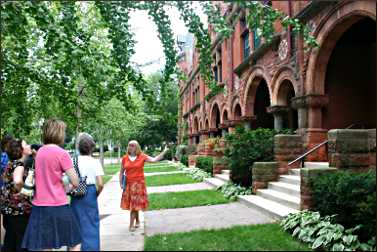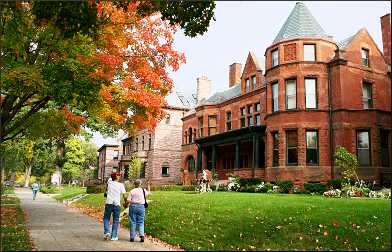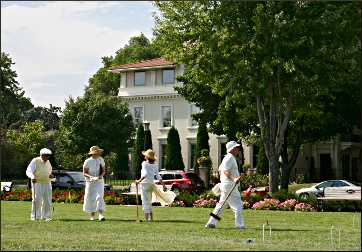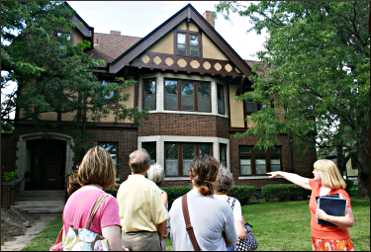Street of dreams
On St. Paul's Summit Avenue, imposing mansions are remnants of the Gilded Age.

© Beth Gauper
Even tourists from the great European capitals are impressed by Summit Avenue.
It's not just one mansion, but one after another, all the way from the Mississippi River to the massive Cathedral of St. Paul, overlooking downtown and the state Capitol.
This five-mile stretch is one of the most splendid, best-preserved Victorian streets in the United States. The oldest are at the east end, on the lip of the bluff overlooking downtown and the Mississippi River.
The richest man in Minnesota built his home there, a 36,000-square-foot Richardsonian Romanesque mansion of red sandstone, with 13 bathrooms and 22 fireplaces.
Today, the James J. Hill House is owned by the Minnesota Historical Society, which gives tours of the 1891 house and walking tours past other mansions built with the spoils of the Gilded Age.
"It was a time when people wanted to spend a lot of money if they had it," said guide Joanne Dolney.
Of course, Frank Lloyd Wright called Summit Avenue "the worst collection of architecture in the world." One of F. Scott Fitzgerald's characters called it "a museum of American architectural failures."
But most people can't help being awed. It's not just the houses, but the stories behind them.
The walking tours start at the house of James J. Hill, a native of Canada who started as a teen-age clerk at the steamboat landing in St. Paul.
He seized opportunities, turning a side business selling wood and coal into a transportation empire: "He always had the right idea of what the area needed," Dolney said.
Eventually, Hill pushed his Great Northern Railway from St. Paul to Seattle via Glacier National Park, which he and his son, Louis, helped develop and promote with the slogan "See America First."

© Beth Gauper
Hill was called the Empire Builder, and his old route, now Amtrak's passenger line across the Great Plains through Glacier, is named for him.
For his fifth house in St. Paul, he picked the best spot on the bluffs, tearing down two houses to get the lot. The rugged red-sandstone house took 300 people three years to build.
Hill's son Louis lived in the more feminine Georgian Revival house next door, which incorporates the neoclassical Beaux-Arts style popular in European capitals, which borrowed it from ancient Rome.
"We didn't trust our own styles here; we always borrowed styles from Europe," Dolney said.
The next few blocks are lined with an astonishing cavalcade of houses, with turrets, towers, columns and such embellishments as carved-stone medallions, nymphs and cherubs.
Summit Avenue hit a rough patch in the 1930s, when some people couldn't afford the taxes, said Dolney, and again in the 1960s, when many of the sprawling, energy-guzzling mansions were chopped up into apartments, some of them little better than flophouses.
In the 1970s, the city sold one mansion for $1, on the condition that the new owners fix it up.
But interest in the Victorian style picked up in the late 1970s and 1980s, along with an interest in preservation. Some of the mansions now are tony condos.
Others became elegant event centers, such as the 1901 Summit Manor house, once home to the owner of Schuneman's department store, which evolved into Dayton's and then Macy's.
Most still are private houses, such as the 1882 Queen Anne next to Louis Hill's house, and when our tour walked by, the 11-bedroom, 13-bath house was on the market for $1.995 million.
"Queen Anne is a wonderful style," Dolney said. "The houses were built with detail, detail, detail; the more detail, the better."
Other mansions were built by newspaper publishers, lumber barons, bankers and manufacturers, many of whom tweaked facades over the years.
Lucius Ordway, the plumbing-company owner whose investment in a struggling Two Harbors sandpaper company helped create the blue-chip behemoth 3M, was among many owners who shed Queen Anne turrets in favor of an Italianate or Tudor look.

© Beth Gauper
"It's amazing how much a house can change," Dolney said. "People were always trying to make them more fashionable."
Then our tour stopped in front of a house that was a little too fashionable. Built in the 1970s, it's a series of low boxes with a front parking lot now shielded by sycamores behind a wrought-iron fence.
"This is not a very popular house on the avenue," Dolney said. "There were a lot of people protesting when this was built. This is what pushed people into starting a preservation group."
Today, people revere the past. Just beyond the 1928 house owned by James J. Hill's daughter Rachel — who married the University of Minnesota football player whose touchdown against the University of Michigan in 1903 helped create the Little Brown Jug rivalry — we came to the University Club on the brow of Ramsey Hill.
Some of its members had walked across the street to Eagle Park to play croquet. With the women wearing straw hats and filmy white blouses and skirts, and the men in vests and white pants, they looked like a throwback to 1912, when the club was built.
The exclusive club was a haunt of F. Scott Fitzgerald, who attended dances there.
The middle-class Fitzgerald grew up around Summit Avenue and hobnobbed with the rich, but his love-hate relationship with them is well-documented and reflected in his short stories and novels, most famously "The Great Gatsby."

© Beth Gauper
"He was always on the outside looking in at the big rich houses," Dolney said.
During the summer of 1919, Fitzgerald lived in a townhouse at 599 Summit, where he completed "This Side of Paradise," his first published novel. There's a plaque in front of the house.
Another famous Minnesota writer, Sinclair Lewis, lived down the street during the previous year, at 516 Summit. The novel Lewis was working on, about the recently deceased J.J. Hill, never was completed.
At Eagle Park we crossed to the less-desirable side of the street. By the mid-1880s, Dolney said, bluff-side land that first sold for $1.50 an acre was going for $500 per frontal foot.
We passed a white pillared house Dolney called the "Gone With the Wind" house and came to a Queen Anne-turned-Tudor that was for sale for $1.885 million. On the sales flyer, Dolney looked in vain for the annual property taxes.
"They probably don't want you to know," she said. "It's a lot, usually about $30,000."
From there, we walked past painted ladies on Virginia Street to Laurel Avenue and the richly embellished 1887 Richardsonian Romanesque rowhouses where Fitzgerald lived briefly with his grandmother.
The walking tour ended at the 1915 limestone Cathedral of St. Paul, which a character in a Fitzgerald story called "a plump white bulldog on its haunches" but which draws hordes of tourists not only for its imposing facade but for its ornate interior, open to the public.
The houses on the rest of Summit Avenue, west of Dale, include Georgian Revivals, Queen Annes and Italianesque manors that are only a little smaller. At 1006 Summit, a 50,000-square-foot Tudor built in 1911 now is the Governor's Residence.
William Mitchell College of Law is nearby, and farther down, Summit splits into a boulevard, passing the campuses of Macalester College and the University of St. Thomas. A few blocks later, it meets the Mississippi River.
Today, Summit still is St. Paul's most prestigious address. It's just as it was in the 1880s: If you live there, you've arrived.
Trip Tips: St. Paul's Summit Avenue
Summit Avenue walking tours: Ninety-minute walking tours start at the J.J. Hill House and are given Saturdays and Sundays from Memorial Day weekend through September, $14, $10 children 5-17.
The tours often fill; call 651-297-2555 for reservations. Tickets include entry to the special-exhibit and portrait room of the Hill house.

© Beth Gauper
Summit Hill House Tour: Every other year, the Summit Hill Association sponsors a tour of 10 to 12 mansions.
James J. Hill House: Regular tours are given year-round, $12, $8 for children 5-17.
Check for evening Nooks and Crannies tours and the many chamber concerts and lectures held at the house. Seasonal programs include Victorian ghost stories at Halloween and Hill House Holidays in December, with costumed actors portraying servants.
Accommodations: The Davidson Mansion is an English Cotswold manor house built in 1915 for a real-estate executive who worked for Hill's Great Northern Railway. It has nine rooms and suites, all with kitchens, and guests have access to the nearby University Club.
Dining and shopping: Just two blocks from the cathedral on Selby Avenue, in a restored 1889 Richardson Romanesque building, W.A. Frost is one of the most romantic places in town, with a tree-shaded stone patio out back.
One block to the south of Summit Avenue, Grand Avenue is the premier shopping, eating and strolling street of St. Paul.
Farther west, Victoria Crossing, at Grand's junction with Victoria, is a shopping and dining hub. Café Latte, a nouveau cafeteria with a wine and pizza bar, is very popular, especially for its desserts.
Information: For more, see Sightseeing in St. Paul.